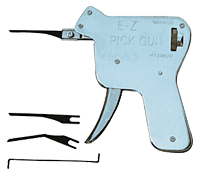 Plenty of web sites and discount catalogs offer lock pick guns for sale, but it is difficult to tell from the ads whether a lock pick gun is a tool worth having. There are problems that accompany their use that are not mentioned in the advertisements. Here is some honest information about the merits, detriments, capabilities, and usefulness of lock pick guns.
Plenty of web sites and discount catalogs offer lock pick guns for sale, but it is difficult to tell from the ads whether a lock pick gun is a tool worth having. There are problems that accompany their use that are not mentioned in the advertisements. Here is some honest information about the merits, detriments, capabilities, and usefulness of lock pick guns.
Lock pick guns work by creating a sharp impact within a pin tumbler lock. When these locks are at rest, top pins cross the shear line between the lock shell and the lock plug. The shear line needs to be clear before the lock will turn. When you put the proper key into the lock, it pushes all the top pins into the shell, but keeps the bottom pins in the plug, leaving the shear line clear. Wrong keys leave top and bottom pins crossing the shear line.
A lock pick gun bounces the pins. A hardened steel needle strikes the bottom pins all at once, sharply. Top pins rest on bottom pins, and the impact is transferred to them just like a rear-ended car jars the car in front of it. Springs in the pin chambers push the top pins down at all times, but spring resistance is pretty weak. After the jarred pins bounce, there is a moment when the shear line is clear, before the springs have pushed the top pins back to their resting positions. In this moment the lock is picked and can be turned.
Lock pick guns do not work on wafer tumbler locks, which do not have top and bottom pins. A person may occasionally open one of these locks with a lock pick gun, but only when the pick needle is used to pick the lock in a conventional fashion. Lock pick guns destroy wafer locks easily, so don’t use them on wafer locks. Pin tumblers are primarily found in house locks, and wafer tumblers are primarily found in automobiles. Lock pick guns can accomplish, sometimes, what conventional lock picks cannot. Some types of pick resistant pins (spool, mushroom, and serrated pins) defy conventional picking techniques, but can be bounced out of the way with a lock pick gun.
Using a lock pick gun requires precision, a delicate touch, excellent timing, and practice. Practice is certain to destroy the locks you are working with, so be warned. Lock pick guns should not be considered non-destructive tools. Pin tumblers are made of brass, and bottom pins are pointed. Very little wear occurs when a brass key is used in a lock, but when the sharp edge of a lock pick gun’s needle slams into the pin, it leaves a dent. Often, a lock pick gun must be triggered 10 or 15 times to open a lock, and these dents compound on a very critical part of the bottom pin : the tip. When it gets too deformed, it will not rest properly on the key. It will be difficult to get the key in and out of the lock, and the lock may cease to function. Lock pick guns also break locks apart internally. They sometimes cause the pin retainer to fly off, letting springs shoot out of the pin chambers. This is not good, and not easy for a non-professional to fix. Locking door knobs are especially susceptible to this.
Lock pick guns can be valid tools, but most locksmiths go months at a time without using them, although they use their conventional picks every day. Other methods of opening locks exist that are less destructive than lock pick guns can be. To use one, the needle must be placed into the keyway perfectly in line with the bottom pins, but not so far that the needle touches the back of the lock. The needle must remain aligned in the keyway as the trigger is pulled, and this requires practice.
Turning tension is the key ingredient to success with a lock pick gun. It should be kept to the barest minimum, or else sideways binding pressure will prevent the top pins from bouncing. There are a few common, successful ways of applying tension while using a lock pick gun. The most successful for opening locks with pick-resistant top pins is one of pure timing. Place the tension wrench in the lock, but do not apply any pressure until a split second after the pick needle has snapped against the bottom pins. This allows the top pins to shoot straight up into the shell before the plug is turned. Spool, mushroom, and serrated pins all count on sideways binding pressure to hamper picking attempts.
This method defeats them, but timing really has to be worked on. It isn’t easy. Initial tension, kept just enough to prevent the tension wrench from falling out of the lock, is fine for most pin tumbler locks, especially for manually operated or homemade lock pick guns. Less tension is needed to use a lock pick gun than is necessary to rake a lock cylinder with standard picks. Beginners have a habit of cranking up their turning pressure as the pick snaps. This is counterproductive. Feathering is the most successful tension technique when using a lock pick gun. All you need to do is vary the amount of tension (stay light!) as you snap the pick. This accomplishes a couple of things: bound pins pushed too far have a chance to drop back into place, and the odds of proper tension the moment after the pick snaps increase over a set push or a single nudge.
Lock pick guns are not a lock opening panacea. They don’t work if the keyhole is curvy, or if the lock doesn’t use pin tumblers, or if the lock doesn’t work smoothly. It takes practice to use them, and the practice is hard on locks. If you are going to use one, be sure to put as little pressure on the tension wrench as possible. This will allow you to use less snapping force with the gun, which leaves less damage inside the lock. Commercial lock pick guns generally have a dial on the side to set the snapping force. An emergency pick gun is shown in the book How to Open Locks With Improvised Tools. It can be made from a coathanger, a bobby pin, and a piece of tape. It is not strong enough to pop the pin retainer off a lock shell’s bible, although it does dent the bottom pins somewhat. A tension wrench is necessary in conjunction with a lock pick gun. They are really easy to make, and the book has directions for those, too. It is wise to use a tension wrench with a longer handle than normal, to keep you aware of how much tension you are using. The tension wrenches that come with commercial lock pick guns are often too short.
Lock pick guns do open locks, but they are not legal in all areas. If you learn other ways to open locks without keys, it won’t be often that you’ll wish you had one. Since a simple one can be made without tools within a few minutes, it probably isn’t a wise investment to order one. Electric lock pick guns cost more than the manual variety, and damage pins at a very rapid rate. If you have a pinning kit and the knowledge needed to replace damaged bottom pins, they can be good tools to use. Battery operation does not remove the requirement for operator skill to successfully use them, however.
Hopefully, this information is helpful to you. Lock pick guns are not nearly as universal a lock opening tool as advertisements portray. They don’t get a lot of use from people who open locks all the time. Certainly, they can be useful, but merely buying one won’t give you any lock picking mastery.
Books on Lock Pick Guns

Pick Guns: Lock Picking For Spies, Cops, And Locksmiths
Pick Guns: Lock Picking For Spies, Cops, And Locksmiths tells how lock pick guns work and how to use them and traces their development from their inception to the revolutionary devices of today. Included are the original patents by Epstein, Segal, Moore, Cooke and others, as well as info on lock pick guns used by the FBI and intelligence agencies. Photos depict improvised devices made out of coat hangers and clothespins.
